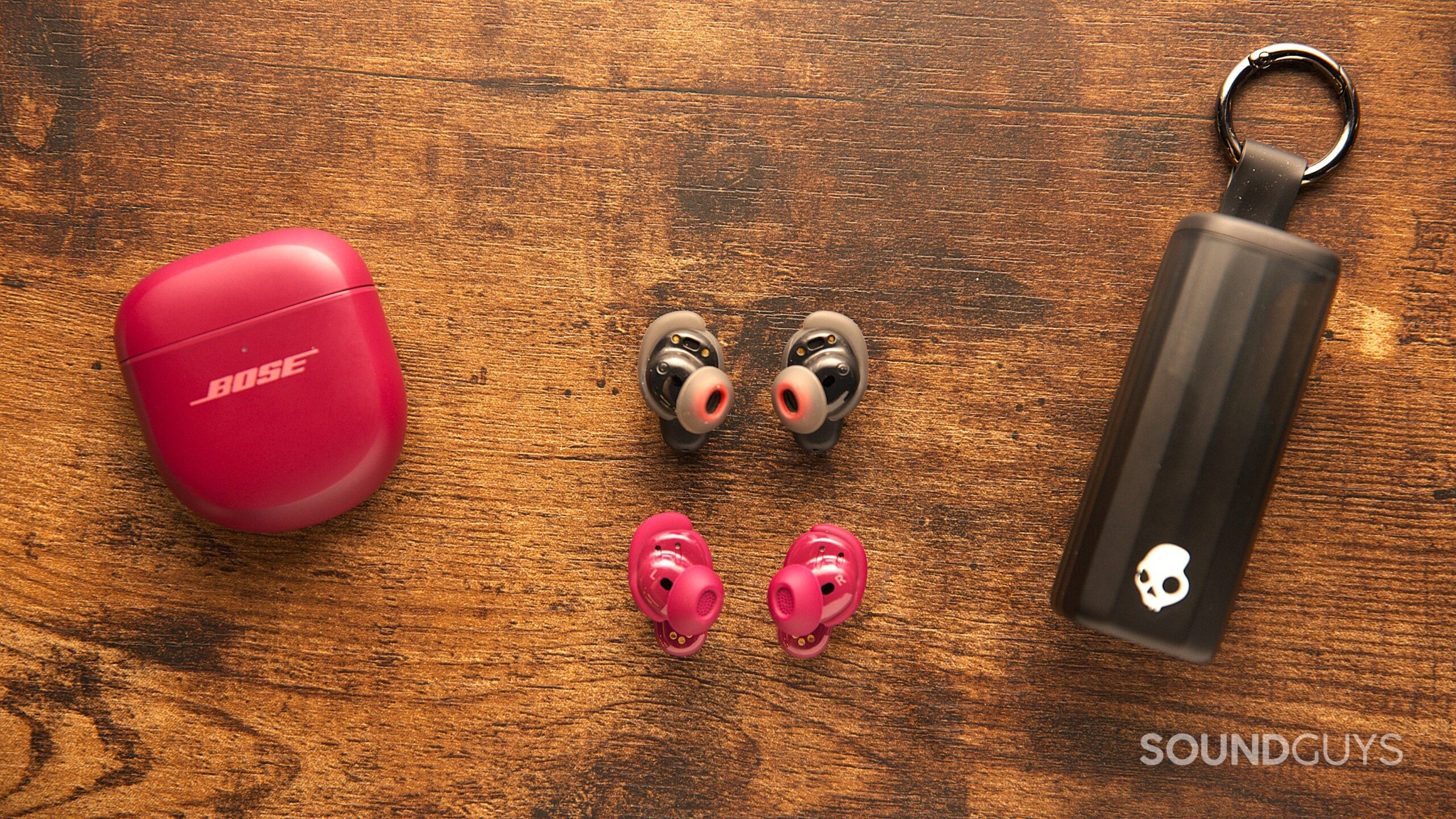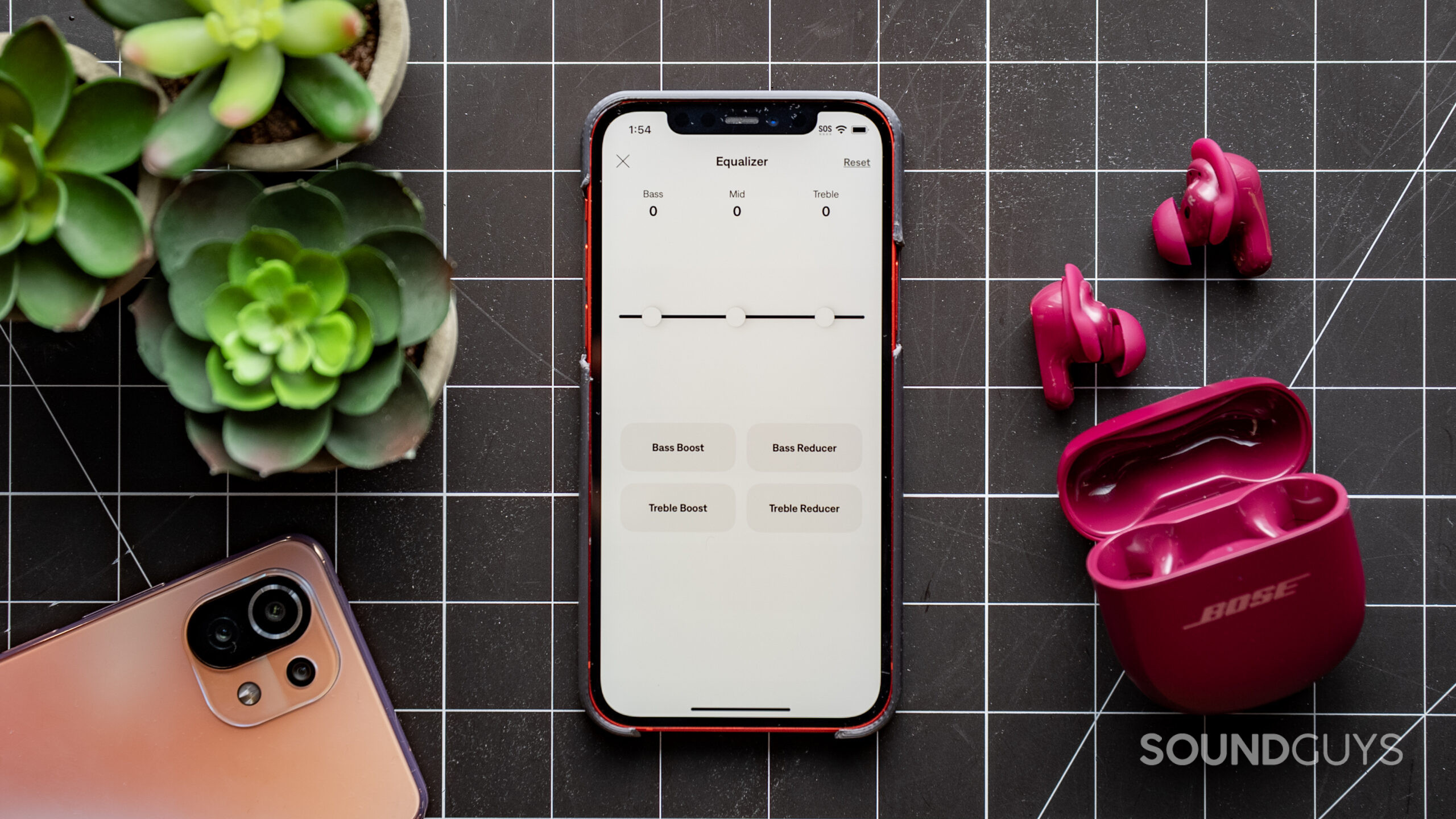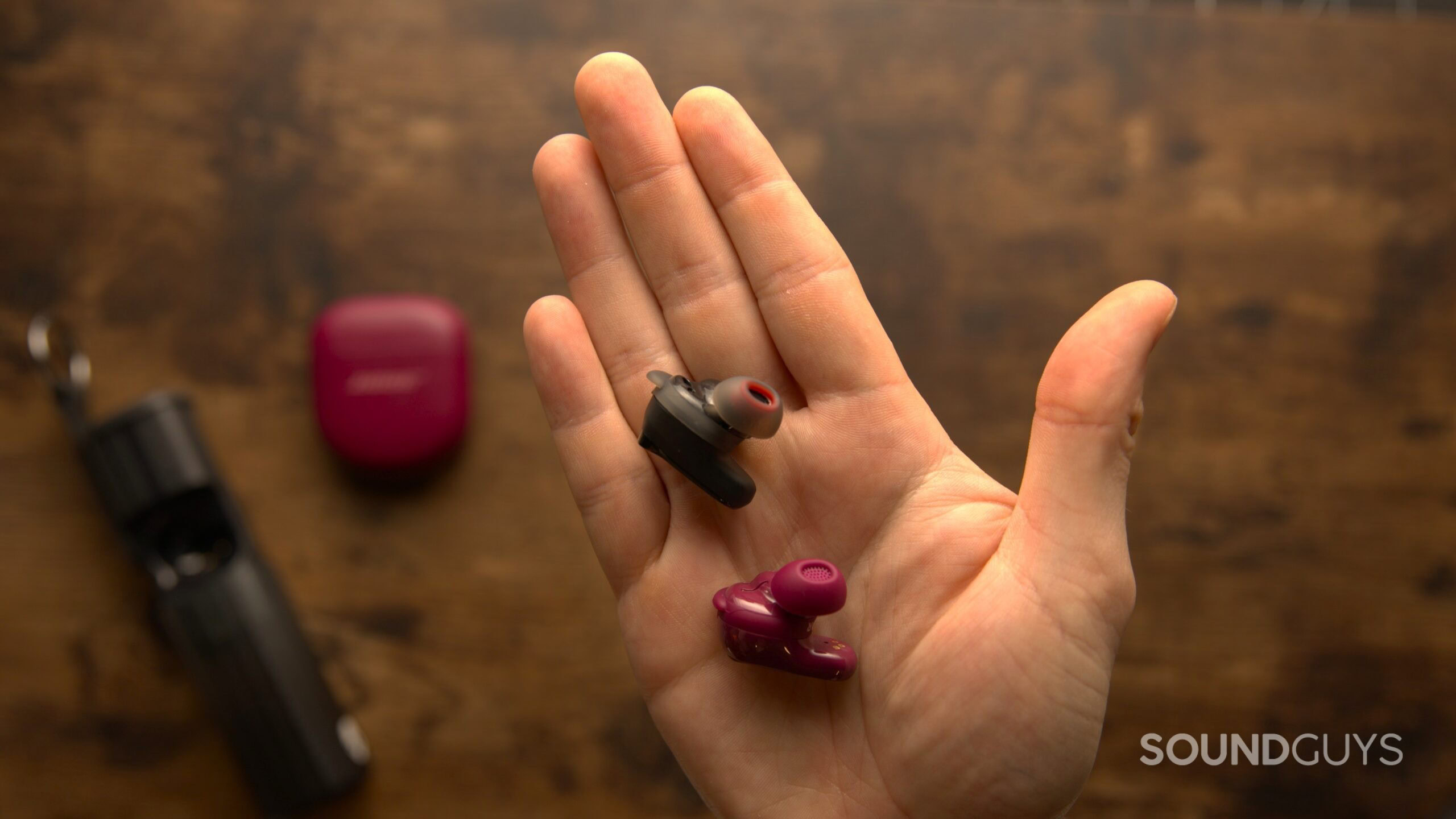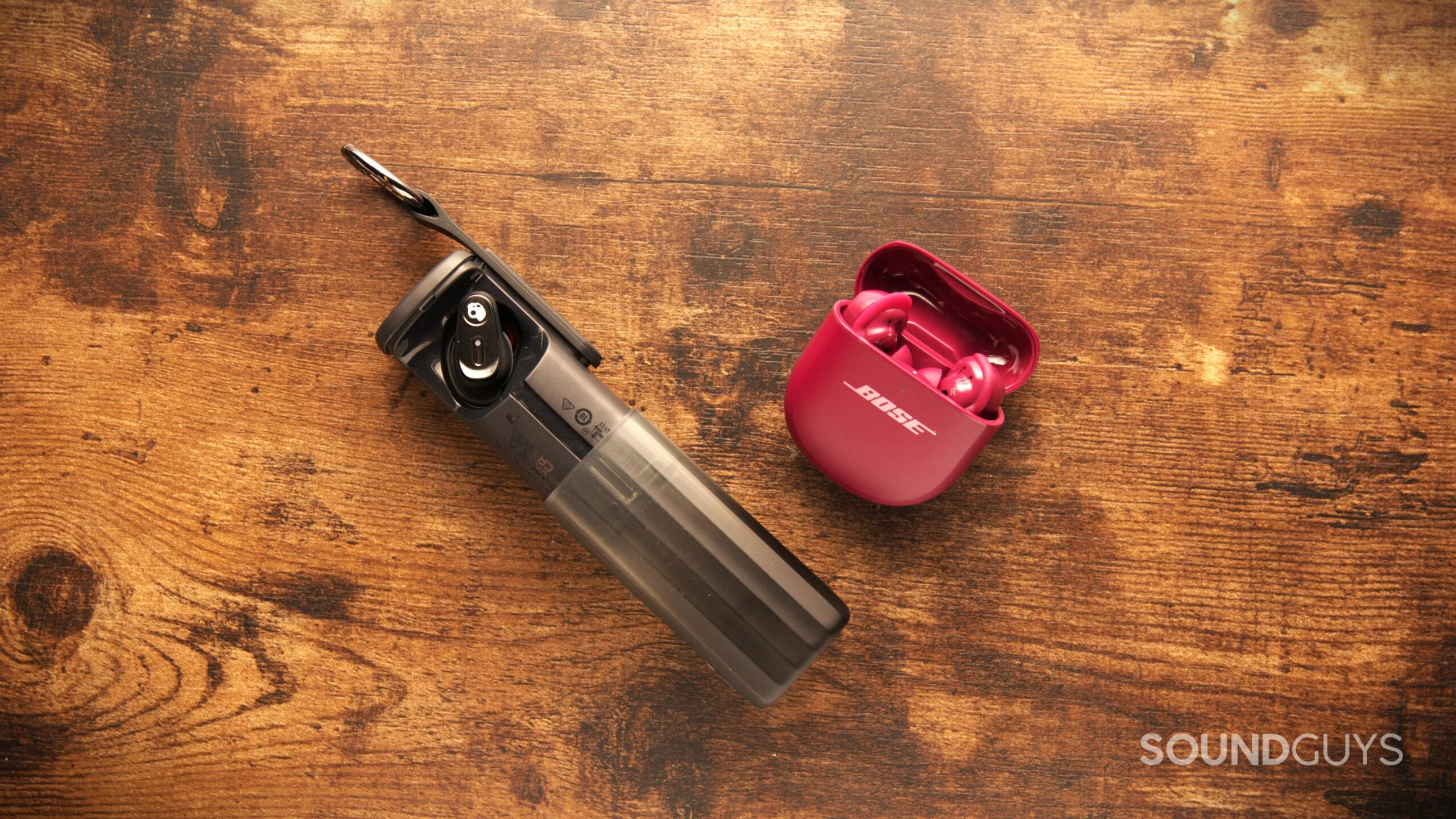All products featured are independently chosen by us. However, SoundGuys may receive a commission on orders placed through its retail links. See our ethics statement.
Bose QuietComfort Ultra Earbuds (2nd Gen) vs Skullcandy Method 360 ANC
July 25, 2025



The Bose QuietComfort Ultra Earbuds (2nd Gen) and the Skullcandy Method 360 ANC may seem like strange rivals on the surface, but they’re more closely related than you’d think. Because the latter comes with “with Sound by Bose,” both earbuds share Bose’s core tuning and hardware influence, but approach the market from wildly different price points and priorities. While Bose offers premium refinement at a premium price, Skullcandy aims to bring some of that Bose polish to budget-conscious users. I tested both earbuds over several weeks, and here’s how they stack up.
This article was originally published on July 25, 2025, and this is the first version.
What’s it like to use the Bose QuietComfort Ultra Earbuds (2nd Gen) compared to the Skullcandy Method 360 ANC?

The Bose QuietComfort Ultra Earbuds (2nd Gen) offer a no-nonsense experience. They feel well-built, albeit a bit bulky, and maintain the same design and clunky case as the original QC Ultra. The ear tips and “stability bands” provide a reliable fit for larger ears, and once they’re seated correctly, I rarely had to adjust them. The intuitive touch controls made daily use easy, and wireless charging on the case added a nice touch of convenience.
The Skullcandy Method 360 ANC, on the other hand, feels designed for style and portability. Though the case is much bulkier with a sliding design and carabiner clip, it suits the more active lifestyle that Skullcandy targets. While the materials feel cheaper, the comfort and fit are impressive thanks to Bose-licensed tips and fins. I liked how the touch controls remained responsive without affecting the earbud seal, which is not always the case with budget models.
| Input | Left earbud | Right earbud |
|---|---|---|
| Input Single tap | Left earbud Play / pause | Right earbud Play / pause |
| Input Double tap | Left earbud Track forward | Right earbud Track forward |
| Input Triple tap | Left earbud Track backward | Right earbud Track backward |
| Input Long press | Left earbud Left programmable shortcut | Right earbud Right programmable shortcut |
| Input Swipe up / down | Left earbud Volume up / down | Right earbud Volume up / down |
| Input | Either Earbud |
|---|---|
Single Tap | Play/Pause Anwser Call |
Double Tap | Track Forward |
Triple Tap | ANC On Stay-Aware Mode On ANC Off |
1 Second Hold | End Call Reject Incoming Call Spotify Tap |
Do the Bose QuietComfort Ultra Earbuds (2nd Gen) or Skullcandy Method 360 ANC have more features?

Bose brings a more focused set of premium features, like aptX Lossless support via Snapdragon Sound (on select Android phones), wireless charging, and deep customization through the Bose app. However, the EQ is frustratingly limited, offering just a 3-band slider with no visible frequency labels. Features like customizable ANC profiles, listening modes, and multipoint connectivity help justify the premium tag.
Skullcandy offers surprising value in this department. Despite the lower price, the Method 360 ANC matches most of Bose’s software offerings and even surpasses them in EQ flexibility. The Skull-iQ app includes a 5-band custom EQ for finer-tuning of levels, adjustable ANC and transparency settings, Spotify Tap integration, and a Studio Mode for low-latency gaming. Even though it shares some of the Bose software backend, Skullcandy makes better use of it for user customization.
How do the Bose QuietComfort Ultra Earbuds (2nd Gen) and Skullcandy Method 360 ANC connect?
Both earbuds use Bluetooth 5.3 and support multipoint connectivity, making it easy to switch between devices like a laptop and a phone. Bose adds aptX Adaptive and aptX Lossless to the mix, which benefits Android users with Snapdragon Sound-compatible phones. Pairing is simple using the physical case button or the Bose app.
Skullcandy sticks to the basics, using SBC and AAC codecs. There’s no aptX here, but multipoint connectivity is still available and works well. Pairing is quick and straightforward, and including Spotify Tap as a mappable function adds a unique flair. While Bose wins on codec support, Skullcandy still nails the essentials.
Is battery life better on the Bose QuietComfort Ultra Earbuds (2nd Gen) or Skullcandy Method 360 ANC?
Battery life is a weak point for the Bose QuietComfort Ultra Earbuds (2nd Gen). In our standardized testing with ANC on, they managed only 5 hours and 34 minutes, which is below average for the category. The case gives you three full recharges and supports wireless charging, but that doesn’t compensate for the short playtime between charges.
Skullcandy pulls ahead with 7 hours and 43 minutes of playback with ANC enabled, and up to 11 hours with ANC off. The case holds up to 40 hours total, which is excellent for travel or all-day listening. Rapid Charging adds two hours of playtime in just 10 minutes. While there’s no wireless charging, the Method 360 ANC still outperforms Bose in longevity.
Do the Bose QuietComfort Ultra Earbuds (2nd Gen) or Skullcandy Method 360 ANC block noise better?
Loading chart ...
Bose’s ANC performance is exceptional. The QuietComfort Ultra Earbuds (2nd Gen) reduce external noise by up to 85% in our testing, particularly in lower frequency ranges. Combined with a secure fit and Bose’s CustomTune tech, these earbuds rank among the best in noise cancelation, even with some low-level noise floor present.
The Skullcandy Method 360 ANC performs surprisingly well with an average attenuation of 80%, but can’t quite match Bose’s level. ANC reduces up to 28dB at low frequencies and 35dB above 1kHz, making it a solid performer in daily environments like public transit or office chatter. Isolation drops without ANC, so I recommend keeping it on for consistent performance. Still, the Method 360 ANC offers some of the best ANC I’ve heard in earbuds under $150.
Do the Bose QuietComfort Ultra Earbuds (2nd Gen) sound better than the Skullcandy Method 360 ANC?
The Bose QuietComfort Ultra Earbuds (2nd Gen) are tuned with a heavy emphasis on bass and treble, creating a V-shaped signature that some may find fun but others, like myself, may find fatiguing. While CustomTune can improve canal-specific tuning, the fixed EQ and overwhelming sub-bass make certain tracks less enjoyable for vocal or midrange-focused genres.
Skullcandy’s Method 360 ANC leans into that same V-shaped tuning even harder. The default sound is bass-heavy to the point of being boomy, and treble peaks can become harsh at higher volumes. But here’s the twist: Skullcandy’s custom 5-band EQ gives you the tools to actually fix it. By adjusting the EQ, I was able to get closer to a balanced sound than with Bose. This made these earbuds more flexible despite their budget branding.
Multi-Dimensional Audio Quality Scores (MDAQS)
Based on HEAD acoustics’ Multi-Dimensional Audio Quality Scores, both earbuds score highly, with Skullcandy Method 360 ANC earning a 4.9 overall and Bose close behind at 4.8. Timbre and Immersiveness are tied at 4.9 and 4.8, respectively, across both models. Distortion scores are low, 3.2 for Bose and 3.1 for Skullcandy, indicating some minor clarity loss. Most listeners will be satisfied with either sound profile, though Skullcandy edges out Bose by offering a more tweakable audio experience.
- Timbre (MOS-T) represents how faithfully the headphones reproduce the frequency spectrum and temporal resolution (timing information).
- Distortion (MOS-D) represents non-linearities and added noise: higher scores mean cleaner reproduction.
- Immersiveness (MOS-I) represents perceived source width and positioning: how well virtual sound sources are defined in three-dimensional space.
Objective Measurements
Loading chart ...
When comparing the two earbuds’ frequency responses, both show significant boosts in sub-bass and treble, with noticeable dips in the mids. Skullcandy pushes this even further, with more extreme low-end emphasis and a sharper 2.5–5kHz treble peak. The result is a punchier, more “energetic” sound, but one that can cause listener fatigue faster. Bose is slightly more reserved and smoother, especially in the highs, but both sets suffer from the same fundamental V-shaped tuning flaws. If you like balanced audio, neither default profile will thrill you.
Do the Bose QuietComfort Ultra Earbuds (2nd Gen) or Skullcandy Method 360 ANC have a better microphone?

Bose’s microphone system performs acceptably in ideal conditions but suffers from some processing artifacts in noisy environments. Office and street recordings revealed a slight struggle with wind and ambient noise, and there’s an audible “noise floor” even with ANC off. It’s good enough for calls, but not exceptional for the price.
Skullcandy actually surprises here, delivering clearer results than expected. The Method 360 ANC mic sounds a bit compressed, but it does a solid job rejecting background noise. In my testing, it held up well on commutes and in the office, though windy environments proved more challenging. While neither mic is perfect, Skullcandy punches above its weight class in this area.
Bose QuietComfort Ultra Earbuds (2nd Gen) microphone demo (Ideal conditions):
Skullcandy Method 360 ANC microphone demo (Ideal conditions):
Bose QuietComfort Ultra Earbuds (2nd Gen) microphone demo (Street conditions):
Skullcandy Method 360 ANC microphone demo (Street conditions):
How do you preserve headphone battery life?
Bose QuietComfort Ultra Earbuds (2nd Gen) vs Skullcandy Method 360 ANC: Price and availability
The Bose QuietComfort Ultra Earbuds (2nd Gen) launched at $299.99 at Amazon and remain positioned as a top-tier option. For that price, you get strong ANC, decent comfort, and flagship-level branding. But considering the minor upgrades over the original model, value is harder to justify unless you find them on sale.
The Skullcandy Method 360 ANC launched at $99.99 at Amazon, but often sells for as low as $99. At this price, it’s an excellent deal, offering Bose hardware fundamentals, robust app features, and long battery life. It’s clear that Skullcandy is aiming to undercut premium earbuds without skipping on essential features, and for many users, that strategy works.
Should you get the Bose QuietComfort Ultra Earbuds (2nd Gen) or Skullcandy Method 360 ANC?

If your top priorities are elite ANC performance, build quality, and brand reputation, the Bose QuietComfort Ultra Earbuds (2nd Gen) are the safer bet, as long as you’re okay with a stock sound that can’t be meaningfully customized. They’re ideal for travel, noisy commutes, or listeners who want a “set-it-and-forget-it” experience and don’t mind spending more.
However, if you’re value-conscious and open to tweaking your audio experience, the Skullcandy Method 360 ANC is shockingly competent. You get Bose drivers, strong ANC, and a far better EQ system, all for a third of the price. Sure, the case design and bass-forward tuning may not appeal to everyone, but if you catch them on sale, they’re arguably the better buy for most people.
Thank you for being part of our community. Read our Comment Policy before posting.